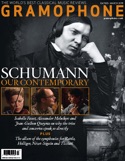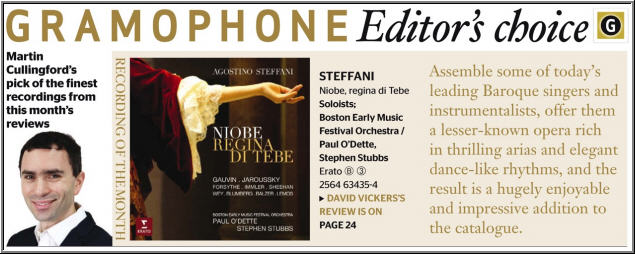Texte paru dans: / Appeared in: |
|
|
Outil de traduction (Très approximatif) |
|
|
Reviewer: David Vickers Agostino Steffani (1653-1728) is praised by scholarly cognoscenti as the missing link between Cavalli and Handel but opportunities to hear top-class performances of his works are much too rare. The discography has expanded gradually in recent years but his operas have not been championed as effectively as his masterful chamber duets (the undisputed model for Handel’s similar duets) and his fine Stabat mater, sent in 1728 to London’s Academy of Ancient of Music (he was their honorary president). Considering the manifold qualities of this unfairly neglected composer, even the most curmudgeonly early-music purist (like me) must concede that Cecilia Bartoli’s recent flurry of glamorous oneoff recitals drawn from secular and sacred output has brought the composer to the attention of the mainstream. However, ‘The peculiar fusion of Italian aria style and Lulliste French dance elements means that courtly dance is never far away’ for those who might have listened uneasily to Bartoli’s albums (12/12 and 11/13) with an intermingled admiration for the composer and reservations about elements of the performances, the Boston Early Music Festival’s masterful interpretation of Niobe, regina di Tebe is a vital breath of fresh air.
Those aware of Steffani’s intriguing career path, from humble boy chorister in his native Padua to eventually becoming one of the pre-eminent Roman Catholic diplomats based in Germany, might usually associate his compositional career with the electoral court at Hanover (where he preceded Handel by a few years), but previously he worked for over 20 years at the Bavarian court in Munich, where Niobe, regina di Tebe was first performed at the Salvatortheater on January 5, 1688. Luigi Orlandi’s libretto is based creatively on a tale in Book 6 of Ovid’s Metamorphoses. The worldweary Anfione, King of Thebes, unwisely transfers power to his wife Niobe but her prideful insults to the gods cause them to destroy her 12 children; Anfione is driven to suicide and the grief-stricken Niobe turns to stone.
Paul O’Dette and Stephen Stubbs
co-directed a staged production of Niobe at the Boston Early Music Festival in
2011 and they have reconvened with a slightly different cast for this fantastic
recording, produced in partnership with Radio Bremen. Aaron Sheehan portrays
Clearte’s hopeless love for Niobe with soft plaintiveness. Colin Balzer’s
valorous Tiberino has a more muscular timbre and his beloved Manto is sung
enchantingly by Amanda Forsythe, some of whose arias feature woodwinds used to
lovely effect. José Lemos sings the comic servant Nerea with relaxed wit and
Christian Immler’s blind seer Tiresia is calmly authoritative, even when treated
abysmally by the arrogant Niobe. The villainous conspirators Creonte (Terry Wey)
and Poliferno (Jesse Blumberg) are characterised with just the right blend of
mischievous personality and musical poise.
The excellent orchestra is led from the front by the co-directing lutenists O’Dette and Stubbs, who bring to life the multifaceted score, whether it is bellicose trumpets and drums (the Sinfonia that begins Act 1 and also Creonte’s victorious aria ending the opera), the French-style pastoral ballet at the end of Act 2, a plethora of delicate arias, or tastefully realised recitatives. The peculiar fusion of Italian aria style and Lulliste French dance elements means that a sense of courtly dance is never far away, even when the mood is occasionally required to be more confrontational or muscular. The performance is never forced but always emotive. The artistic directors prepared their performing edition from nine different sources, including the printed libretto which revealed additional ballet music was composed by Melchior d’Ardespin (1643-1717), the director of the Bavarian court orchestra; his dances are lost but suitable movements have been selected from two other operas performed at Munich in 1690. Similarly, a few small gaps in the surviving material of Steffani’s music have been filled editorially, such as the Sinfonias that begin Acts 2 and 3. Steffani made lots of cuts in advance of the first performance but some material omitted from the Bostonian production has been reinstated for the Bremen recording. Decisions are explained with exemplary clarity in O’Dette’s postscript to Colin Timms’s expert essay. An exemplary testament of superb musicianship from all participants (orchestral and vocal) and evidence of the artistic good that can come from a healthy scholarly curiosity, this is a landmark event in Steffani’s much-deserved rehabilitation. |
|
|
|
|
|
Cliquez l'un ou l'autre
bouton pour découvrir bien d'autres critiques de CD |
|




